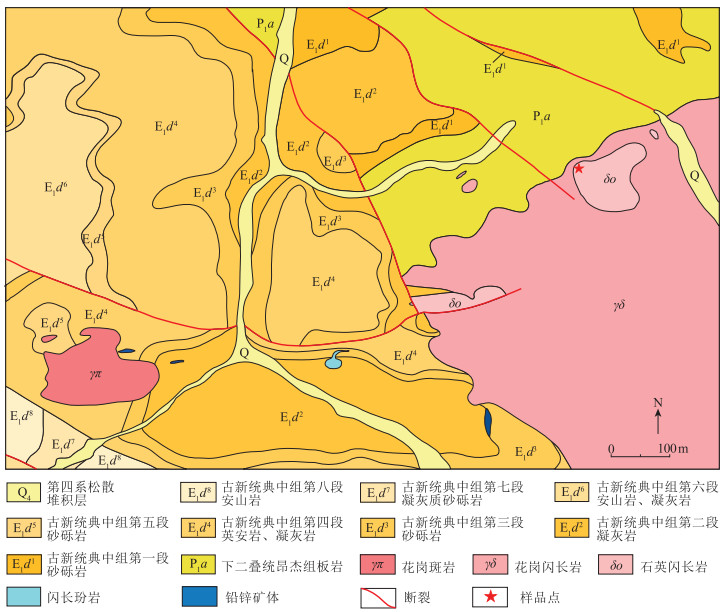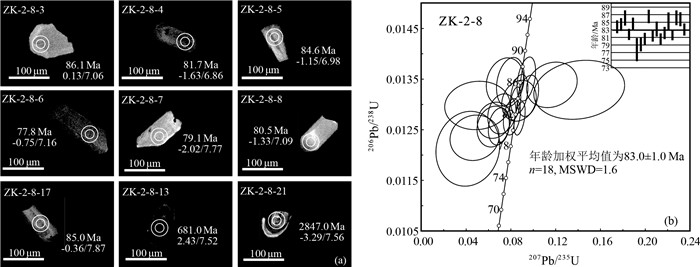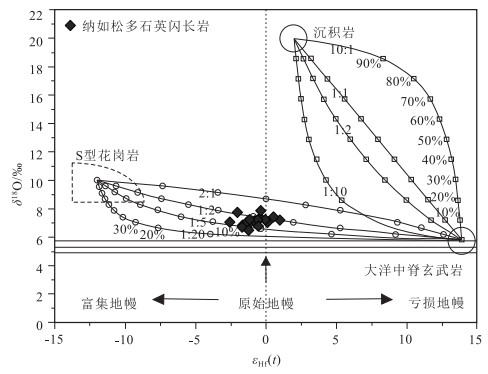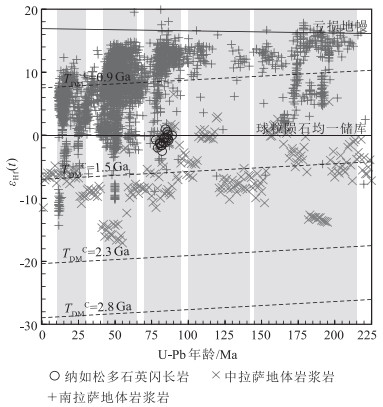In situ zircon Hf-O isotopic characteristics and petrogenesis of Late Cretaceous quartz diorite in the Narusongduo Pb-Zn mining area, Tibet
-
摘要:
拉萨地体的增生演化受到新特提斯洋俯冲的制约, 新特提斯洋于中生代启动北向俯冲, 在拉萨地体南部形成晚白垩世"岩浆大爆发"。纳如松多铅锌矿床位于中拉萨地体南缘, 矿区内晚白垩世石英闪长岩的岩浆源区特征及成因机制目前尚未得到很好的解释。通过矿区内该石英闪长岩的SHRIMP锆石U-Pb年龄与Hf-O同位素组成研究, 结果表明, 纳如松多石英闪长岩结晶年龄为83.0±1.0 Ma, 锆石εHf(t)和二阶段模式年龄TDM2分别为-2.6~1.0(平均值为-0.8)和1139~1363 Ma(平均值为1253 Ma); δ18O值介于6.5‰~7.9‰之间(平均值为7.2‰)。锆石原位Hf-O同位素组成指示, 石英闪长岩源区具有壳幔二端元混合的特征, 二端元混合模式计算显示幔源岩浆贡献较大, 且存在成熟地壳物质加入。纳如松多石英闪长岩与南拉萨地体晚白垩世岩浆的活动时间和动力学背景一致, 是拉萨地体南部晚白垩世岩浆大爆发事件的一部分, 指示由新特提斯洋北向俯冲引起的晚白垩世强烈岩浆活动的范围不局限于南拉萨地体, 还延伸到中拉萨地体。
Abstract:The accretion and evolution of the Lhasa Terrane is restricted by the subduction of the Neo-Tethys Ocean.The northward subduction of the Neo-Tethys Ocean started in the Mesozoic and formed the Late Cretaceous "magmatic burst" event in the south Lhasa Terrane.The Narusongduo Pb-Zn deposit is located in the southern margin of the central Lhasa Terrane.The nature of the magma source and petrogenesis of the quartz diorite in the mining district have not been well documented.The zircon SHRIMP U-Pb age and Hf-O isotopic characteristics of the quartz diorite are systematically reported in this study.The quartz diorite has SHRIMP U-Pb ages of 83.0 ±1.0 Ma, εHf(t)values of -2.6 to 1.0(mean = -0.8)and the corresponding TDM2 of 1088 Ma to 1312 Ma(mean=1253 Ma), and δ18O values between 6.5‰ and 7.9 ‰(average value = 7.2‰), indicative of an enriched source.In situ zircon Hf-O isotopic compositions display a binary mixing trend between mantle and continental crust, with the mixing calculations show in the mantle as a primary contributor.The Narusongduo quartz diorite has similar ages and geodynamic setting as the Late Cretaceous "magmatic burst" event in the southern part of Lhasa Terrane, implying that the Late Cretaceous magmatic activities triggered by the northward subduction of the Neo-Tethys Ocean were not limited in the south Lhasa Terrane and also extended to the central Lhasa Terrane.
-
Keywords:
- quartz diorite /
- U-Pb ages /
- Hf-O isotopes /
- central Lhasa Terrane /
- Tibet
-
拉萨地体是青藏高原南部重要的构造单元[1],不仅记录了青藏高原从中生代新特提斯洋洋壳俯冲消减[2-3]到新生代印-亚大陆碰撞[4]的构造演化过程,还发育了西藏近80%的岩浆岩[5-6],以及与岩浆活动有关的铜、金、钼、铅、锌、铁等金属矿床,吸引了国内外学者的广泛关注。近年,随着青藏高原地质调查和科学研究工作的不断深入,对拉萨地体内岩浆活动的研究日趋深化,积累了大量年龄和地球化学数据,极大地提升了对青藏高原碰撞造山带大尺度壳幔相互作用、岩石圈结构演化及大规模成岩成矿作用机制的认识[1-6]。
拉萨地体南部发育有大规模的晚白垩世岩浆活动[7],被称为晚白垩世的“岩浆大爆发”[8]。虽然对于拉萨地体南部晚白垩世岩浆活动的成因机制和深部过程还存在较多争议,但前人研究普遍认为其与新特提斯洋的俯冲有关。多种观点的差异主要集中于雅鲁藏布江洋壳的俯冲方式是高角度俯冲[9-10]还是低角度俯冲[11-12],或是洋脊俯冲[3, 13-14]。纳如松多铅锌矿床地处中拉萨地体南缘,位于中、南拉萨地体过渡位置。印亚大陆主碰撞期的成岩成矿作用是此前该矿床的研究重点[15-17],近年在矿区内又识别出成矿前侵位的晚白垩世石英闪长岩[18]。岩石地球化学和Sr-Nd-Pb同位素地球化学研究表明,其源区物质可能来自于新特提斯洋洋壳俯冲产生的岛弧地幔楔的部分熔融[19]。但其岩浆源区究竟具有怎样的组成特征,岩浆作用形成的地球动力学背景是否与拉萨地体南部广泛发育的晚白垩世岩浆活动一致,仍需进一步探讨。
锆石是中酸性岩浆岩中普遍存在的、对Hf-O同位素组成具有良好保存性的副矿物,因此对讨论岩浆源区和示踪岩浆演化过程具有较好的指示作用[20-28]。本文以纳如松多矿区晚白垩世石英闪长岩为研究对象,通过SHRIMP锆石U-Pb定年及Hf-O同位素分析,为其物质来源及成因机制提供新的制约。
1. 地质概况与样品特征
青藏高原自北向南分为松潘-甘孜地体、羌塘地体、拉萨地体和喜马拉雅地体4个东西向地体[4, 29]。拉萨地体也被称为冈底斯带,是夹持于班公湖-怒江缝合带和印度河-雅鲁藏布缝合带之间的重要构造单元(图 1),也是一条巨型构造-岩浆岩带[4-5, 31-34]。根据地壳基底和沉积盖层的不同,拉萨地体自北向南被狮泉河-纳木错混杂岩带、洛巴堆-米拉山断裂分为北拉萨地体、中拉萨地体和南拉萨地体3个次级构造单元[8](图 1)。拉萨地体的元古宙—太古宙结晶基底主要分布于中拉萨地体,沉积盖层包括寒武纪—晚中生代几乎连续的地层[3, 35]。地体内岩浆活动频繁且具明显的阶段性,形成了215~145 Ma、142~100 Ma、95~70 Ma、65~42 Ma和30~12 Ma五个峰期[36],中生代岩浆岩广泛分布在中、北拉萨地体之上[3, 34],而南拉萨地体以分布晚三叠世—中新世冈底斯岩基和古新世—始新世林子宗群火山岩为主[35, 37-38]。多期次、大规模的岩浆活动为成矿作用创造了条件,形成了包括冈底斯北侧银铅锌多金属成矿带在内的多条大型多金属成矿带。
![]() 图 1 拉萨地体地质简图a—拉萨地体构造单元;b—拉萨地体中生代岩浆岩分布简图(据参考文献[30]修改)Figure 1. Geological sketch map of the Lhasa Terrane
图 1 拉萨地体地质简图a—拉萨地体构造单元;b—拉萨地体中生代岩浆岩分布简图(据参考文献[30]修改)Figure 1. Geological sketch map of the Lhasa Terrane西藏日喀则谢通门县纳如松多铅锌矿床位于中拉萨地体南缘(图 1-b),是冈底斯北侧银铅锌多金属成矿带内的大型矿床。矿区地层主要由下二叠统昂杰组板岩(P1a1)、中二叠统下拉组灰岩(P2x2)、古新统典中组火山岩(E1d)和全新统松散堆积物(Q4)组成(图 2),其中典中组在矿区广泛发育,自西向东连续分布。矿区构造与区域构造方向一致,为近东西走向,其中发育的2条近东西走向的逆冲断裂,是矿区内的主干断裂,具有多期活动特征,对岩浆活动和铅锌成矿具有重要的控制作用,并在成矿后进一步活动,改造了矿化带的展布。2条主干断裂夹持的中部地带,发育近东西向褶皱。此外,矿区还普遍发育裂隙及破碎带,并以各向裂隙最发育。矿区内岩浆岩分布广泛,尤以典中组火山岩最发育(图 2)。典中组火山岩以中基性为主,岩性主要为玄武安山岩、安山岩、英安岩、英安质凝灰熔岩、熔结凝灰岩、安山质熔结火山角砾岩等。矿区东部可见石英闪长岩、花岗闪长岩侵入下二叠统昂杰组板岩中,随后被近东西向和北西向逆断层切割,沿断裂发育铅锌矿化,指示石英闪长岩和花岗闪长岩就位于成矿前。矿区中部发育的花岗斑岩岩株与铅锌成矿关系密切,侵入二叠系沉积岩和古新统火山岩中,伴随有隐爆角砾岩型和矽卡岩型铅锌矿化产出。斑岩体中心为粗斑花岗斑岩,年龄62.54 Ma[15];斑岩体外围为细斑花岗斑岩,年龄为62.47 Ma [15]。通过矿区内隐爆角砾岩型矿体内热液绢云母40Ar-39Ar坪年龄约束成矿年龄为57.81 Ma[16]。矿区中西部发育的少量闪长玢岩脉穿切铅锌矿体,为成矿后的侵入岩。矿区内普遍发育矽卡岩化、绿帘石化、绿泥石化、高岭土化、硅化等蚀变类型。
![]() 图 2 纳如松多矿区东段地质图(据参考文献[18]修改)Figure 2. Geological map of the eastern Narusongduo mining area
图 2 纳如松多矿区东段地质图(据参考文献[18]修改)Figure 2. Geological map of the eastern Narusongduo mining area样品ZK-2-8采集于矿区东部石英闪长岩岩株西北缘的钻孔ZK-2岩心137.5 m处,样品新鲜无蚀变,呈灰黑色(图 3-a),半自形细粒结构,块状构造,主要由斜长石(55%~60%)、角闪石(10%~15%)、石英(约15%)及少量钾长石(约5%)和黑云母(约5%)组成。镜下观察斜长石具较弱的环带结构和显著的聚片双晶,偶见绢云母化(图 3-b、c)。
2. 测试方法与结果
2.1 测试方法
新鲜的岩石样品在河北省诚信地质服务公司破碎和分选,挑选出的单颗粒锆石在北京离子探针中心制靶,随后进行透射光、反射光和阴极发光拍照。根据显微图像避开锆石内包裹体、裂纹等位置,选择结构均匀、生长环带规则部位开展锆石原位U-Pb定年和Hf-O同位素测试。
锆石U-Pb年龄测试在北京离子探针中心的SHRIMP Ⅱ上完成, 详细分析方法及原理见参考文献[39-40]。测试时一次流O2-强度为3~5 nA,束斑直径25~30 μm。未知样品的U-Pb年龄和锆石U含量分别采用标样TEM(年龄417 Ma[41])和M257(U=840×10-6[42])进行校正。实验过程中,每测试3个样品点,测试一次标样进行U-Pb同位素分馏校正。数据采用SQUID和ISOPLOT程序[43]进行处理。普通铅校正依据实测204Pb进行,同位素比值和单点年龄误差均为1σ。
锆石氧同位素在北京离子探针中心多接收器二次离子质谱仪(SHRIMP Ⅱe-MC)上完成。首先对年龄样品靶进行抛光并清洗烘干,在样品靶表面镀金膜,厚度约12 nm。测试时,在定年时的测点位置进行原位氧同位素分析,以确保获得的氧同位素值与年龄值对应。实验过程中,剥蚀束斑直径为20 μm,每测试3个样品点采用标样TEM(δ18O=8.2‰)进行校正,并监控仪器稳定性。分析结果(δ18O)以VSMOW为标准报道,分析精度为0.2‰~0.3‰,详细分析流程及原理见参考文献[44]。
锆石Lu-Hf同位素测试在中国地质科学院地质研究所LA-MC-ICP-MS实验室完成。实验仪器为Thermo Fisher公司Neptune Plus型多接收等离子质谱仪(MC-ICP-MS)与193 nm准分子激光剥蚀系统(GeoLasPro)。测试位置与定年及O同位素测试点位相同,测试束斑直径为44 μm。实验标样为GJ-1,其176Hf/177Hf加权平均值为0.282008±20,与推荐值在误差范围内一致。仪器运行条件和分析流程见参考文献[45],Hf同位素计算公式见参考文献[46]。
2.2 测试结果
2.2.1 锆石U-Pb年龄
石英闪长岩样品ZK-2-8锆石为无色透明至浅棕色,多数呈短柱状,振荡环带较宽,部分锆石具核-边结构(图 4-a),18个测点得到的206Pb/238U表面年龄为88.9~77.8 Ma(表 1),年龄加权平均值为83.0±1.0 Ma(MSWD=1.6)(图 4-b)。Th和U含量分别介于192×10-6~815×10-6和150×10-6~665×10-6之间,Th/U值为0.77~1.79,显著高于变质重结晶锆石的Th/U值(小于0.1),为岩浆成因锆石[47-49]。另有3个测点分别得到681±24 Ma、2467±7 Ma、2847±10 Ma的年龄值,结合Th/U值推测,其为岩浆侵位过程中的捕获锆石。在年龄谐和图(图 4-b)上,获得的岩浆锆石U-Pb同位素数据(表 1)显示了较好的206Pb/238U与207Pb/235U谐和性,可代表测试锆石的结晶年龄。
![]() 图 4 纳如松多矿区石英闪长岩部分锆石阴极发光图像、测试位置、年龄和εHf(t)/δ18O值(a)及SHRIMP锆石U-Pb谐和图(b)(小圆圈为SHRIMP U-Pb和O同位素测点,大圆圈为LA-MC-ICP-MS Hf同位素测点,测点旁数字为U-Pb年龄和εHf(t)/δ18O值)Figure 4. Cathodeluminescence images of zircons from the Narusongduo quartz diorite with their ages, εHf(t)and δ18O values(a)and SHRIMP U-Pb concordia diagram of zircons(b)表 1 纳如松多铅锌矿床石英闪长岩锆石SHRIMP U-Pb年龄分析结果Table 1. Zircon SHRIMP U-Pb ages of quartz diorite in the Narusongduo Pb-Zn deposit
图 4 纳如松多矿区石英闪长岩部分锆石阴极发光图像、测试位置、年龄和εHf(t)/δ18O值(a)及SHRIMP锆石U-Pb谐和图(b)(小圆圈为SHRIMP U-Pb和O同位素测点,大圆圈为LA-MC-ICP-MS Hf同位素测点,测点旁数字为U-Pb年龄和εHf(t)/δ18O值)Figure 4. Cathodeluminescence images of zircons from the Narusongduo quartz diorite with their ages, εHf(t)and δ18O values(a)and SHRIMP U-Pb concordia diagram of zircons(b)表 1 纳如松多铅锌矿床石英闪长岩锆石SHRIMP U-Pb年龄分析结果Table 1. Zircon SHRIMP U-Pb ages of quartz diorite in the Narusongduo Pb-Zn deposit测点号 含量/10-6 Th/U 同位素比值 年龄/Ma Th U 207Pb/206Pb 1σ(%) 207Pb/235U 1σ(%) 206Pb/238U 1σ(%) 206Pb/238U 1σ ZK-2-1-1 414 242 1.77 0.0484 11.5 0.09 11.7 0.0131 2.0 83.8 1.7 ZK-2-1-2 317 199 1.65 0.0525 6.2 0.10 6.5 0.0132 2.0 84.3 1.7 ZK-2-1-3 589 364 1.67 0.0429 10.0 0.08 10.3 0.0134 2.4 86.1 2.1 ZK-2-1-4 261 351 0.77 0.0460 5.9 0.08 6.2 0.0128 1.9 81.7 1.5 ZK-2-1-5 436 264 1.70 0.0480 5.5 0.09 5.9 0.0132 2.0 84.6 1.6 ZK-2-1-6 359 214 1.73 0.0249 45.0 0.04 45.2 0.0121 4.0 77.8 3.1 ZK-2-1-7 385 222 1.79 0.0280 30.3 0.05 30.4 0.0124 2.4 79.1 1.9 ZK-2-1-8 401 343 1.21 0.0370 14.7 0.06 14.8 0.0126 2.1 80.5 1.7 ZK-2-1-9 235 180 1.35 0.0477 7.0 0.09 7.3 0.0139 2.3 88.9 2.0 ZK-2-1-10 453 265 1.76 0.0504 5.4 0.09 5.8 0.0135 2.1 86.5 1.8 ZK-2-1-11 815 665 1.27 0.0372 15.2 0.07 15.3 0.0127 1.9 81.3 1.5 ZK-2-1-12 351 220 1.65 0.0280 38.3 0.05 38.4 0.0130 2.4 83.2 2.0 ZK-2-1-13 167 730 0.24 0.0622 1.1 0.86 2.0 0.1005 1.6 617.2 9.5 ZK-2-1-14 505 358 1.46 0.0400 8.9 0.07 9.1 0.0126 1.9 80.5 1.5 ZK-2-1-15 277 836 0.34 0.1611 0.4 9.83 1.7 0.4426 1.6 2362 32 ZK-2-1-16 483 288 1.73 0.0407 11.4 0.07 11.5 0.0128 2.0 82.1 1.7 ZK-2-1-17 286 187 1.58 0.0770 18.8 0.14 19.0 0.0133 2.9 85.0 2.4 ZK-2-1-18 192 150 1.33 0.0403 14.5 0.07 14.7 0.0135 2.3 86.1 2.0 ZK-2-1-19 467 279 1.73 0.0632 12.6 0.12 12.8 0.0134 2.2 85.7 1.9 ZK-2-1-20 437 253 1.78 0.0470 8.5 0.08 8.8 0.0130 2.0 83.0 1.6 ZK-2-1-21 164 158 1.07 0.2026 0.6 15.3 1.8 0.5476 1.7 2815 39 2.2.2 锆石Hf-O同位素地球化学特征
锆石Hf-O同位素测试结果见表 2。纳如松多矿区晚白垩世石英闪长岩锆石Hf-O同位素测定值变化范围较小,176Hf/177Hf=0.280953~0.282749,fLu/Hf平均值为-0.98,εHf(t)=-2.6~1.0(t=83 Ma),平均值为-0.8,利用平均地壳fLu/Hf=-0.5和176Lu/177Hf=0.015,获得二阶段模式年龄为1139~1363 Ma,平均为1253 Ma,显示中元古代的地壳模式年龄;δ18O=6.5‰~7.9‰,平均值为7.2‰,累积频数直方图显示单峰分布特征(图 5-b)。
表 2 纳如松多铅锌矿床石英闪长岩锆石原位Hf-O同位素组成Table 2. Zircon Hf-O isotopic compositions of quartz diorites in the Narusongduo Pb-Zn deposit测点号 176Yb/177Hf 176Lu/177Hf 176Hf/177Hf 2σ εHf(t) tDM/Ma tDM2/Ma δ18O/‰ 1σ T/Ma ZK-2-8-1 0.0234 0.00069 0.282710 0.000019 -0.4 761 1227 7.4 0.2 83.7 ZK-2-8-2 0.0233 0.00068 0.282749 0.000020 1.0 707 1139 7.2 0.3 84.3 ZK-2-8-3 0.0225 0.00066 0.282723 0.000016 0.1 743 1198 7.1 0.3 86.1 ZK-2-8-4 0.0195 0.00060 0.282676 0.000021 -1.6 807 1304 6.9 0.2 81.7 ZK-2-8-5 0.0169 0.00050 0.282688 0.000020 -1.2 788 1277 7.0 0.3 84.6 ZK-2-8-6 0.0187 0.00056 0.282703 0.000025 -0.8 769 1243 7.2 0.1 77.7 ZK-2-8-7 0.0263 0.00076 0.282667 0.000021 -2.0 823 1324 7.8 0.3 79.1 ZK-2-8-8 0.0105 0.00033 0.282685 0.000019 -1.3 789 1284 7.1 0.2 80.5 ZK-2-8-9 0.0141 0.00043 0.282717 0.000017 0.0 747 1211 7.3 0.2 88.9 ZK-2-8-10 0.0221 0.00066 0.282697 0.000019 -0.8 779 1257 7.1 0.3 86.5 ZK-2-8-11 0.0172 0.00052 0.282675 0.000015 -1.7 807 1306 6.7 0.2 81.3 ZK-2-8-12 0.0118 0.00036 0.282705 0.000016 -0.6 762 1239 7.2 0.2 83.1 ZK-2-8-13 0.0263 0.00080 0.282465 0.000016 2.4 1107 1778 7.5 0.2 617.2 ZK-2-8-14 0.0145 0.00044 0.282688 0.000020 -1.2 787 1277 6.5 0.2 80.5 ZK-2-8-15 0.0209 0.00071 0.281216 0.000021 -3.2 2815 4533 — — 2362 ZK-2-8-16 0.0221 0.00065 0.282650 0.000019 -2.6 845 1363 7.1 0.2 82.1 ZK-2-8-17 0.0165 0.00049 0.282710 0.000017 -0.4 758 1227 7.9 0.2 85.1 ZK-2-8-18 0.0136 0.00041 0.282704 0.000019 -0.5 764 1241 6.8 0.2 86.1 ZK-2-8-19 0.0185 0.00054 0.282735 0.000019 0.5 724 1171 7.4 0.2 85.7 ZK-2-8-20 0.0197 0.00057 0.282689 0.000019 -1.1 789 1275 7.2 0.4 83.0 ZK-2-8-21 0.0400 0.00120 0.280953 0.000019 -3.3 3209 5100 7.6 0.3 2815 3. 讨论
3.1 岩石成因
普遍认为俯冲背景下的中性岩可以通过俯冲板片脱水产生的流体交代地幔楔形成的钙碱性基性岩浆演化[50-52]、俯冲板片熔融形成的熔体交代地幔楔熔融[53-56]、玄武质下地壳重熔[57]及幔源岩浆和壳源岩浆混合[58-66]形成。俯冲带形成的钙碱性基性岩浆在较低温度条件下,可以通过斜长石、角闪石及Fe-Ti氧化物的连续分离结晶使残余熔体SiO2含量上升,形成中性岩[67]。这类中性岩往往具有富集不相容元素和亏损高场强元素的特征。总体上,纳如松多石英闪长岩显示出富集强不相容元素(Rb、Th、U等)、亏损高场强元素(Nb、Ta、Ti等)的特征[19],与受到板片脱水流体交代的源区熔融形成的中性岩浆岩相似。然而,该岩体岩相单一,具有相对均一的SiO2含量(60.26%~61.50%),显示岩浆分异程度较弱,且SiO2与MgO、TFeO、Cr和Ni未显示负相关关系[19],指示岩浆演化过程中未发生强烈的铁镁矿物和Fe-Ti氧化物分离结晶;含水岩浆中斜长石普遍结晶较晚,且全岩稀土元素显示微弱的Eu异常,暗示岩浆未经历过斜长石的高度分离结晶。因此,幔源基性岩浆直接分异并非纳如松多石英闪长岩的成因。此外,该岩体具有较高的Nb/Ta值(11.1~13.8[19]),介于全球平均下地壳(8.3[68])与地幔(17.7[69])之间,也不支持玄武质下地壳部分熔融,或基性岩浆分离结晶的成因。
较之脱水流体交代,地幔楔受到板片熔融的熔体交代后会富集重稀土元素与高场强元素[70],这与纳如松多石英闪长岩强烈亏损重稀土元素与高场强元素的特征[19]不一致。熔体交代的地幔楔具有相对亏损的同位素组成,因此该地幔楔部分熔融形成的岩浆会具有亏损的Nd-Hf同位素组成。而纳如松多石英闪长岩的εHf(t)= -2.6~1.0,εNd(t)=-5.8~-5.2[19],显示了较富集的源区特征。因此,纳如松多石英闪长岩不是熔体交代的地幔楔部分熔融形成的。
纳如松多石英闪长岩的εHf(t)平均值为-0.8,而其εNd(t)介于-5.8~-5.2之间[19],Nd同位素比Hf同位素更富集,显示出与Hf同位素解耦的现象。岩浆岩中Nd-Hf同位素解耦,往往与2个过程有关:①岩浆混合导致εNd(t)降低[71];②较老的地壳部分熔融时由于锆石效应,熔融形成的岩浆较源区物质更富集放射性Hf同位素而具有高的εHf(t)[72-73]。古老下地壳部分熔融产生的Nd-Hf解耦岩浆往往形成S型花岗岩,且具有较高的氧同位素组成(δ18O>8‰)[72]。这些地球化学特征均说明,纳如松多石英闪长岩不是单独的下地壳部分熔融的产物,源区可能存在地幔物质的加入。纳如松多石英闪长岩中锆石氧同位素不均一,δ18O值介于6.5‰~ 7.9‰之间,且高于幔源岩浆结晶形成的锆石的δ18O值(5.3± 0.3‰[22, 74]),暗示岩浆形成过程中存在岩浆混合作用。利用石英闪长岩全岩的SiO2含量(60.66%[18]) 估算出全岩的δ18O值为7.7‰~9.1‰(δ18O锆石-全岩 = δ18O锆石- δ18O全岩≈ -0.0612(wt.%SiO2)+2.5[22]),与全球典型I型花岗岩的全岩O同位素组成(δ18O= 6‰~10‰[75-76])基本一致,指示地壳重融过程中有幔源物质的贡献[77-79]。笔者采用εHf(t)-δ18O图解对不同端元岩浆参与纳如松多石英闪长岩的比例进行了二端元混合模式模拟(图 6)。其中,成熟地壳和俯冲洋壳物质端元分别采用典型S型花岗岩和沉积岩的平均同位素组成,大洋中脊玄武岩的同位素组成作为地幔物质端元。在该图解中,纳如松多石英闪长岩锆石Hf-O同位素组成落入幔源(大洋中脊玄武岩)组分与壳源(S型花岗岩)组分之间(图 6)。通过模拟计算得到成熟地壳组分约有40%的贡献,指示纳如松多石英闪长岩源区主要为地幔组分贡献,但存在成熟地壳物质的加入。中拉萨地体普遍具有元古宙—太古宙的结晶基底[3],结合锆石Hf-O同位素分析结果及模拟计算结果,笔者认为,纳如松多石英闪长岩很可能是俯冲板片流体交代地幔楔形成的幔源岩浆上侵后诱发中拉萨地体元古宙—太古宙结晶基底熔融,随后由底侵的玄武质岩浆与地壳熔融形成的长英质岩浆混合形成。
![]() 图 6 纳如松多矿区石英闪长岩锆石原位εHf(t)-δ18O关系图解(据参考文献[80]修改; 不同端元Hf-O同位素数据据参考文献[81-82];大洋中脊玄武岩: δ18O=5.8‰, εHf(t)=13.9;沉积岩: δ18O=20‰, εHf(t)=2; S型花岗岩: δ18O=10‰, εHf(t)=-12);混合线根据不同Hf大洋中脊玄武岩/ Hf沉积岩(1∶10~10∶1)和Hf大洋中脊玄武岩/Hf花岗岩(2∶1~1∶20) 值做出,圆圈与正方形表示混合比例(10%间隔))Figure 6. Binary plot of in-situ zircon δ18O values vs εHf(t)values of the Narusongduo quartz diorites
图 6 纳如松多矿区石英闪长岩锆石原位εHf(t)-δ18O关系图解(据参考文献[80]修改; 不同端元Hf-O同位素数据据参考文献[81-82];大洋中脊玄武岩: δ18O=5.8‰, εHf(t)=13.9;沉积岩: δ18O=20‰, εHf(t)=2; S型花岗岩: δ18O=10‰, εHf(t)=-12);混合线根据不同Hf大洋中脊玄武岩/ Hf沉积岩(1∶10~10∶1)和Hf大洋中脊玄武岩/Hf花岗岩(2∶1~1∶20) 值做出,圆圈与正方形表示混合比例(10%间隔))Figure 6. Binary plot of in-situ zircon δ18O values vs εHf(t)values of the Narusongduo quartz diorites3.2 地球动力学背景
南拉萨地体晚白垩世岩浆活动非常发育[36],且呈带状平行于雅鲁藏布江缝合带分布[35],因此被称为晚白垩世的“岩浆大爆发”[7-8]。中拉萨地体晚白垩世岩浆活动较南拉萨地体弱,对其动力学背景的研究也相对较少。以往研究按照花岗岩构造判别图解和微量元素特征,提出纳如松多石英闪长岩为产出在活动大陆边缘的陆缘弧岩浆岩,暗示其构造环境总体为新特提斯洋板块向拉萨地体的持续俯冲挤压与间歇性伸展[19]。晚白垩世纳如松多石英闪长岩锆石Hf-O同位素等研究表明,其是壳幔相互作用的产物。因此笔者认为,新特提斯洋的阶段性俯冲,导致洋壳板片脱水并交代上覆地幔楔,诱发地幔楔部分熔融,底侵产生的玄武质岩浆使地壳部分熔融,并发生小规模岩浆混合。随后俯冲板片后撤造成上覆板片伸展,为混合后的岩浆上升侵位提供了优势条件,形成了纳如松多演化程度较低的中性石英闪长岩。
纳如松多石英闪长岩侵位年龄为83.0 Ma,在时间上与拉萨地体南部晚白垩世“岩浆大爆发”事件时限一致[7-8]。前人对南拉萨地体晚白垩世岩浆成因与动力学机制进行了大量研究,提出多种认识,包括正常安第斯型岛弧岩浆作用[8, 83-84]、加厚地壳的部分熔融[11-12]、俯冲板片脱水交代地幔楔部分熔融[9-10]和新特提斯洋脊俯冲诱发下地壳岩石部分熔融[3, 13, 85-86]。多数学者认为,该岩浆作用为新特提斯洋俯冲板片断离,诱发地幔楔部分熔融,产生的岩浆上侵诱发下地壳部分熔融的产物[8, 28, 30, 87-91]。总体上,纳如松多石英闪长岩也是在这种成因机制和地球动力学背景下形成的。中拉萨地体地壳厚度约70 km,较地壳厚度75 km的南拉萨地体薄[92],且具有元古宙—太古宙的结晶基底,这可能是其具有比南拉萨地体晚白垩世岩浆岩更短的分异结晶过程及更多的成熟物质混入的原因。因此,由新特提斯洋北向俯冲引起的晚白垩世岩浆活动范围可能不局限于南拉萨地体,在中拉萨地体也存在岩浆活动的响应,这些同时期岩浆活动可能是同一动力学过程的产物。
3.3 对拉萨地体构造演化的制约
拉萨地体的增生演化受到新特提斯洋演化的制约[33-34, 37, 93-95]。中生代,新特提斯洋启动向北俯冲[83],在拉萨地体内形成了一系列的岩浆活动[37, 93-94, 96-97]。前人研究[36]发现拉萨地体内的这些岩浆活动具有阶段性,形成了215~145 Ma、142~100 Ma、95~70 Ma、65~42 Ma和30~12 Ma几个峰期,指示新特提斯洋的俯冲可能具有多阶段的特征。这几个阶段可能与俯冲板片后撤或斜向俯冲过程中,俯冲带上盘经历了弧上伸展有关[98-105]。在这个伸展过程中,地幔物质上涌诱发地壳部分熔融,形成大量壳源岩浆。底侵的玄武质岩浆与壳源岩浆混合,形成具有相对亏损的同位素特征的岩浆。
南拉萨地体和中拉萨地体的岩浆活动虽然在这几个峰期均有发育,但是具有显著不同的Hf同位素特征(图 7)。与南拉萨地体中岩体普遍具有亏损的Hf同位素组成不同,中拉萨地体的岩体大多具有富集的Hf同位素组成,显示2个地体具有不同的岩浆源区和壳幔相互作用过程,并导致形成岩浆的地壳物质比例有很大差异。值得注意的是,2个地体在不同的岩浆峰期具有不同的Hf同位素漂移,暗示了2个地体动力学演化过程的差异。例如,中拉萨地体和南拉萨地体的岩体在95~70 Ma均有显著的Hf同位素正漂移,指示在95~70 Ma两个地体均有大量地幔物质上涌而发生强烈的壳幔相互作用。而在65~42 Ma,南拉萨地体依然表现出Hf同位素正漂移,但是中拉萨地体则有显著的负漂移,显示出南拉萨地体有持续的地幔物质贡献,而中拉萨地体在该时间主要是地壳部分熔融,地幔物质参与较少。在30~12 Ma,两个地体表现出与65~42 Ma相反的Hf同位素漂移,但均体现出地幔物质贡献减少的特征。这些特征暗示,在新特提斯洋俯冲的不同阶段,岩浆的形成机制存在差异,地幔上涌主要位于南拉萨地体之下,因此对南拉萨地体的岩浆活动长期有显著贡献,但对中拉萨地体的贡献主要在95~70 Ma这期岩浆活动。证实了晚白垩世“岩浆大爆发”在中拉萨地体也有体现。
![]() 图 7 纳如松多矿区石英闪长岩锆石εHf(t)与U-Pb年龄图解(中拉萨和南拉萨地体数据据参考文献[36]及其引文;灰色阴影指示拉萨地体内5个岩浆活动峰期)Figure 7. Diagram of εHf(t)values versus U-Pb ages of zircons from quartz diorite in the Narusongduo mining area
图 7 纳如松多矿区石英闪长岩锆石εHf(t)与U-Pb年龄图解(中拉萨和南拉萨地体数据据参考文献[36]及其引文;灰色阴影指示拉萨地体内5个岩浆活动峰期)Figure 7. Diagram of εHf(t)values versus U-Pb ages of zircons from quartz diorite in the Narusongduo mining area4. 结论
(1) 纳如松多矿区石英闪长岩SHRIMP锆石U-Pb年龄为83.0±1.0 Ma,其锆石εHf(t)=-2.6~1.0,均值为-0.8;δ18O=6.5‰~7.9‰,均值为7.2‰,暗示其主要来源于地幔组分,并存在成熟地壳物质的加入。
(2) 纳如松多晚白垩世岩浆活动的时间及地球化学特征与拉萨地体南部晚白垩世“岩浆大爆发”形成的岩浆岩相似,因此具有相同的成因与地球动力学背景,是拉萨地体南部晚白垩世“岩浆大爆发”事件的一部分。
(3) 晚白垩世新特提斯洋阶段性俯冲,洋壳板片脱水并交代上覆地幔楔,使地幔楔部分熔融形成玄武质岩浆。随后玄武质岩浆底侵至下地壳,诱发地壳部分熔融,并与形成的壳源岩浆发生小规模岩浆混合,形成了纳如松多矿区演化程度较低的中性石英闪长岩。
致谢: 野外工作得到西藏宝翔矿业有限公司工作人员的大力支持,中国科学院地质与地球物理研究所的朱明帅博士后、中国地质科学院地质研究所的王铮老师在实验过程中提供了指导和帮助,审稿专家提出了许多建设性意见,在此一并表示衷心的感谢。 -
图 1 拉萨地体地质简图
a—拉萨地体构造单元;b—拉萨地体中生代岩浆岩分布简图(据参考文献[30]修改)
Figure 1. Geological sketch map of the Lhasa Terrane
图 2 纳如松多矿区东段地质图(据参考文献[18]修改)
Figure 2. Geological map of the eastern Narusongduo mining area
图 4 纳如松多矿区石英闪长岩部分锆石阴极发光图像、测试位置、年龄和εHf(t)/δ18O值(a)及SHRIMP锆石U-Pb谐和图(b)
(小圆圈为SHRIMP U-Pb和O同位素测点,大圆圈为LA-MC-ICP-MS Hf同位素测点,测点旁数字为U-Pb年龄和εHf(t)/δ18O值)
Figure 4. Cathodeluminescence images of zircons from the Narusongduo quartz diorite with their ages, εHf(t)and δ18O values(a)and SHRIMP U-Pb concordia diagram of zircons(b)
图 6 纳如松多矿区石英闪长岩锆石原位εHf(t)-δ18O关系图解
(据参考文献[80]修改; 不同端元Hf-O同位素数据据参考文献[81-82];大洋中脊玄武岩: δ18O=5.8‰, εHf(t)=13.9;沉积岩: δ18O=20‰, εHf(t)=2; S型花岗岩: δ18O=10‰, εHf(t)=-12);混合线根据不同Hf大洋中脊玄武岩/ Hf沉积岩(1∶10~10∶1)和Hf大洋中脊玄武岩/Hf花岗岩(2∶1~1∶20) 值做出,圆圈与正方形表示混合比例(10%间隔))
Figure 6. Binary plot of in-situ zircon δ18O values vs εHf(t)values of the Narusongduo quartz diorites
图 7 纳如松多矿区石英闪长岩锆石εHf(t)与U-Pb年龄图解
(中拉萨和南拉萨地体数据据参考文献[36]及其引文;灰色阴影指示拉萨地体内5个岩浆活动峰期)
Figure 7. Diagram of εHf(t)values versus U-Pb ages of zircons from quartz diorite in the Narusongduo mining area
表 1 纳如松多铅锌矿床石英闪长岩锆石SHRIMP U-Pb年龄分析结果
Table 1 Zircon SHRIMP U-Pb ages of quartz diorite in the Narusongduo Pb-Zn deposit
测点号 含量/10-6 Th/U 同位素比值 年龄/Ma Th U 207Pb/206Pb 1σ(%) 207Pb/235U 1σ(%) 206Pb/238U 1σ(%) 206Pb/238U 1σ ZK-2-1-1 414 242 1.77 0.0484 11.5 0.09 11.7 0.0131 2.0 83.8 1.7 ZK-2-1-2 317 199 1.65 0.0525 6.2 0.10 6.5 0.0132 2.0 84.3 1.7 ZK-2-1-3 589 364 1.67 0.0429 10.0 0.08 10.3 0.0134 2.4 86.1 2.1 ZK-2-1-4 261 351 0.77 0.0460 5.9 0.08 6.2 0.0128 1.9 81.7 1.5 ZK-2-1-5 436 264 1.70 0.0480 5.5 0.09 5.9 0.0132 2.0 84.6 1.6 ZK-2-1-6 359 214 1.73 0.0249 45.0 0.04 45.2 0.0121 4.0 77.8 3.1 ZK-2-1-7 385 222 1.79 0.0280 30.3 0.05 30.4 0.0124 2.4 79.1 1.9 ZK-2-1-8 401 343 1.21 0.0370 14.7 0.06 14.8 0.0126 2.1 80.5 1.7 ZK-2-1-9 235 180 1.35 0.0477 7.0 0.09 7.3 0.0139 2.3 88.9 2.0 ZK-2-1-10 453 265 1.76 0.0504 5.4 0.09 5.8 0.0135 2.1 86.5 1.8 ZK-2-1-11 815 665 1.27 0.0372 15.2 0.07 15.3 0.0127 1.9 81.3 1.5 ZK-2-1-12 351 220 1.65 0.0280 38.3 0.05 38.4 0.0130 2.4 83.2 2.0 ZK-2-1-13 167 730 0.24 0.0622 1.1 0.86 2.0 0.1005 1.6 617.2 9.5 ZK-2-1-14 505 358 1.46 0.0400 8.9 0.07 9.1 0.0126 1.9 80.5 1.5 ZK-2-1-15 277 836 0.34 0.1611 0.4 9.83 1.7 0.4426 1.6 2362 32 ZK-2-1-16 483 288 1.73 0.0407 11.4 0.07 11.5 0.0128 2.0 82.1 1.7 ZK-2-1-17 286 187 1.58 0.0770 18.8 0.14 19.0 0.0133 2.9 85.0 2.4 ZK-2-1-18 192 150 1.33 0.0403 14.5 0.07 14.7 0.0135 2.3 86.1 2.0 ZK-2-1-19 467 279 1.73 0.0632 12.6 0.12 12.8 0.0134 2.2 85.7 1.9 ZK-2-1-20 437 253 1.78 0.0470 8.5 0.08 8.8 0.0130 2.0 83.0 1.6 ZK-2-1-21 164 158 1.07 0.2026 0.6 15.3 1.8 0.5476 1.7 2815 39 表 2 纳如松多铅锌矿床石英闪长岩锆石原位Hf-O同位素组成
Table 2 Zircon Hf-O isotopic compositions of quartz diorites in the Narusongduo Pb-Zn deposit
测点号 176Yb/177Hf 176Lu/177Hf 176Hf/177Hf 2σ εHf(t) tDM/Ma tDM2/Ma δ18O/‰ 1σ T/Ma ZK-2-8-1 0.0234 0.00069 0.282710 0.000019 -0.4 761 1227 7.4 0.2 83.7 ZK-2-8-2 0.0233 0.00068 0.282749 0.000020 1.0 707 1139 7.2 0.3 84.3 ZK-2-8-3 0.0225 0.00066 0.282723 0.000016 0.1 743 1198 7.1 0.3 86.1 ZK-2-8-4 0.0195 0.00060 0.282676 0.000021 -1.6 807 1304 6.9 0.2 81.7 ZK-2-8-5 0.0169 0.00050 0.282688 0.000020 -1.2 788 1277 7.0 0.3 84.6 ZK-2-8-6 0.0187 0.00056 0.282703 0.000025 -0.8 769 1243 7.2 0.1 77.7 ZK-2-8-7 0.0263 0.00076 0.282667 0.000021 -2.0 823 1324 7.8 0.3 79.1 ZK-2-8-8 0.0105 0.00033 0.282685 0.000019 -1.3 789 1284 7.1 0.2 80.5 ZK-2-8-9 0.0141 0.00043 0.282717 0.000017 0.0 747 1211 7.3 0.2 88.9 ZK-2-8-10 0.0221 0.00066 0.282697 0.000019 -0.8 779 1257 7.1 0.3 86.5 ZK-2-8-11 0.0172 0.00052 0.282675 0.000015 -1.7 807 1306 6.7 0.2 81.3 ZK-2-8-12 0.0118 0.00036 0.282705 0.000016 -0.6 762 1239 7.2 0.2 83.1 ZK-2-8-13 0.0263 0.00080 0.282465 0.000016 2.4 1107 1778 7.5 0.2 617.2 ZK-2-8-14 0.0145 0.00044 0.282688 0.000020 -1.2 787 1277 6.5 0.2 80.5 ZK-2-8-15 0.0209 0.00071 0.281216 0.000021 -3.2 2815 4533 — — 2362 ZK-2-8-16 0.0221 0.00065 0.282650 0.000019 -2.6 845 1363 7.1 0.2 82.1 ZK-2-8-17 0.0165 0.00049 0.282710 0.000017 -0.4 758 1227 7.9 0.2 85.1 ZK-2-8-18 0.0136 0.00041 0.282704 0.000019 -0.5 764 1241 6.8 0.2 86.1 ZK-2-8-19 0.0185 0.00054 0.282735 0.000019 0.5 724 1171 7.4 0.2 85.7 ZK-2-8-20 0.0197 0.00057 0.282689 0.000019 -1.1 789 1275 7.2 0.4 83.0 ZK-2-8-21 0.0400 0.00120 0.280953 0.000019 -3.3 3209 5100 7.6 0.3 2815 -
Zhang K J, Zhang Y X, Tang X C, et al. Late Mesozoic tectonic evolution and growth of the Tibetan Plateau prior to the Indo-Asian collision[J]. Earth Science Reviews, 2012, 114: 236-249. doi: 10.1016/j.earscirev.2012.06.001
Zhu D C, Mo X X, Niu Y L, et al. Geochemical investigation of Early Cretaceous igneous rocks along an east-west traverse throughout the central Lhasa terrane, Tibet[J]. Chemical Geology, 2009, 268: 298-312. doi: 10.1016/j.chemgeo.2009.09.008
Zhu D C, Zhao Z D, Niu Y L, et al. The Lhasa terrane: Record of a microcontinent and its histories of drift and growth[J]. Earth and Planetary Science Letters, 2011, 301(1/2): 241-255.
Yin A, Harrison T M. Geologic evolution of the Himalayan-Tibetan orogeny[J]. Annual Review of Earth and Planetary Science, 2000, 28: 211-280. doi: 10.1146/annurev.earth.28.1.211
莫宣学, 董国臣, 赵志丹, 等. 西藏冈底斯带花岗岩的时空分布特征及地壳生长演化信息[J]. 高校地质学报, 2005, 11(3): 281-290. doi: 10.3969/j.issn.1006-7493.2005.03.001 莫宣学, 赵志丹, 朱弟成, 等. 西藏南部印度-亚洲碰撞带岩石圈: 岩石学-地球化学约束[J]. 地球科学—中国地质大学学报, 2009, 34(1): 17-27. https://www.cnki.com.cn/Article/CJFDTOTAL-DQKX200901004.htm 朱弟成, 潘桂棠, 王立全, 等. 西藏冈底斯带中生代岩浆岩的时空分布和相关问题的讨论[J]. 地质通报, 2008, 27(9): 1535-1550. doi: 10.3969/j.issn.1671-2552.2008.09.013 Ma L, Wang Q, Li Z X, et al. Early late Cretaceous(ca. 93 Ma)norites and hornblendites in the Milin area, eastern Gangdese: Lithosphere-asthenosphere interaction during slab rollback and an insight into early Late Cretaceous(ca. 100~80 Ma)magmatic "flare-up" in southern Lhasa(Tibet)[J]. Lithos, 2013, 172-173: 17-30. doi: 10.1016/j.lithos.2013.03.007
王莉, 曾令森, 高利娥, 等. 藏南冈底斯岩基东南缘早白垩世高镁-高Sr/Y含单斜辉石闪长岩[J]. 岩石学报, 2013, 29(6): 1977-1994. https://www.cnki.com.cn/Article/CJFDTOTAL-YSXB201306010.htm 高家昊, 曾令森, 郭春丽, 等. 藏南冈底斯岩基晚白垩世构造岩浆作用: 以拉萨白堆复合岩体中-基性岩脉群为例[J]. 岩石学报, 2017, 33(8): 2412-2436. https://www.cnki.com.cn/Article/CJFDTOTAL-YSXB201708006.htm Wen D R, Chung S L, Song B, et al. Late Cretaceous Gangdese intrusions of adakitic geochemical characteristics, SE Tibet: Petrogenesis and tectonic implication[J]. Lithos, 2008, 105(1/2): 1-11.
Wen D R, Liu D Y, Chung S L, et al. Zircon SHRIMP U-Pb ages of the Gangdese batholith and implications for Neotethyan subduction in southern Tibet[J]. Chemical Geology, 2008, 252(3/4): 191-201.
管琪, 朱弟成, 赵志丹, 等. 西藏南部冈底斯带东段晚白垩世埃达克岩: 新特提斯洋脊俯冲的产物?[J]岩石学报, 2010, 26(7): 2165-2179. https://www.cnki.com.cn/Article/CJFDTOTAL-YSXB201007019.htm 欧新锋, 杨锋, 康志强, 等. 西藏拉萨地块南部啊扎侵入体锆石U-Pb年龄、地球化学特征及其对新特提斯洋演化历史的指示[J]. 地质通报, 2022, 41(5): 774-787. http://dzhtb.cgs.cn/gbc/ch/reader/view_abstract.aspx?file_no=20220505&flag=1 纪现华, 杨竹森, 于玉帅, 等. 西藏纳如松多铅锌矿床成矿岩体形成机制: 岩浆锆石证据[J]. 矿床地质, 2012, 31(4): 758-774. doi: 10.3969/j.issn.0258-7106.2012.04.008 纪现华, 孟祥金, 杨竹森, 等. 西藏纳如松多隐爆角砾岩型铅锌矿床绢云母Ar-Ar定年及其地质意义[J]. 地质与勘探, 2014, 50(2): 281-290. https://www.cnki.com.cn/Article/CJFDTOTAL-DZKT201402008.htm 刘英超, 纪现华, 侯增谦, 等. 一个与岩浆作用有关的独立铅锌成矿系统的建立——以西藏纳如松多铅锌矿床为例[J]. 岩石矿物学杂志, 2015, 34(4): 539-556. doi: 10.3969/j.issn.1000-6524.2015.04.008 龚雪婧, 杨竹森, 赵晓燕, 等. 西藏纳如松多铅锌矿区晚白垩世侵入岩形成机制及其地质意义: 岩浆锆石证据[J]. 矿床地质, 2018, 37(1): 91-104. https://www.cnki.com.cn/Article/CJFDTOTAL-KCDZ201801007.htm 龚雪婧, 杨竹森, 庄亮亮, 等. 西藏纳如松多铅锌矿床晚白垩世石英闪长岩成因: 地球化学及Sr-Nd-Pb同位素证据[J]. 矿床地质, 2019, 38(1): 48-60. https://www.cnki.com.cn/Article/CJFDTOTAL-KCDZ201901004.htm Mojzsis S J, Harrison T M, Pidgeon R T. Oxygen-isotope evidence from ancient zircons for liquid water at the earth's surface 4300Myr ago[J]. Nature, 2001, 409(6817): 178-181. doi: 10.1038/35051557
Peck W H, Valley J W, Wilde S A, et al. Oxygen isotope ratios and rare earth elements in 3.3 to 4.4 Ga zircons: Ion microprobe evidence for high δ18O continental crust and oceans in the early Archean[J]. Geochemica et Cosmochimica Acta, 2001, 65(22): 4215-4229. doi: 10.1016/S0016-7037(01)00711-6
Valley J W, Lackey J S, Cavosie A J, et al. 4.4 billion years of crustal maturation: Oxygen isotope ratios of magmatic zircon[J]. Contributions to Mineralogy and Petrology, 2005, 150(6): 61-580.
Booth A L, Kolodny Y, Chamberlain C P, et al. Oxygen isotopic composition and U-Pb discordance in zircon[J]. Geochimica et Cosmochimica Acta, 2005, 69(20): 4895-4905. doi: 10.1016/j.gca.2005.05.013
Li X H, Li W X, Wang X C, et al. Role of Mantle-Derived Magma in Genesis of EarlyYanshanian Granites in the Nanling Range, South China: In Situ Zircon Hf-O Isotopic Constraints[J]. Science in China(Series D), 2009, 52(9): 1262-1278. doi: 10.1007/s11430-009-0117-9
Li X H, Li W X, Li Q L, et al. Petrogenesis and tectonic significance of the ~850Ma Gangbian alkaline complex in South China: Evidence from in situ zircon U-Pb dating, Hf-O isotopes and whole-rock geochemistry[J]. Lithos, 2010, 114(1/2): 1-15.
Cavosie A J, Valley J W, Kita N T, et al. The origin of high δ18O zircons: marbles, megacrysts, and metamorphism[J]. Contributions to Mineralogy and Petrology, 2011, 162(5): 961-974. doi: 10.1007/s00410-011-0634-3
Grimes C B, Ushikubo T, Kozdon, R, et al. Perspectives on the origin of plagiogranite in ophiolites from oxygen isotopes in zircon[J]. Lithos, 2013, 179: 48-66. doi: 10.1016/j.lithos.2013.07.026
Chen Y P, Wei C J, Zhang J R, et al. Metamorphism and zircon U-Pb dating of garnet amphibolite in theBaoyintu group, Inner Mongolia[J]. Science Bulletin, 2015, 60(19): 1698-1707. doi: 10.1007/s11434-015-0890-0
Pan G T, Wang L Q, Li R S, et al. Tectonic evolution of the Qinghai-Tibet Plateau[J]. Journal of Asian Earth Sciences, 2012, 53: 3-14. doi: 10.1016/j.jseaes.2011.12.018
唐演, 赵志丹, 齐宁远, 等. 西藏冈底斯岩基南木林晚白垩世岩体和脉岩地球化学与岩石成因[J]. 岩石学报, 2019, 35(2): 387-404. https://www.cnki.com.cn/Article/CJFDTOTAL-YSXB201902008.htm Dewey J F, ShackletonR M, Chang C F, et al. The tectonic evolution of the Tibetan Plateau[J]. Philosophical Transactions of the Royal Society of London, 1988, A327: 379-413.
Pearce J A, Deng W M. The ophiolites of the Tibetan Geotraverses, Lhasa to Golmud(1985)and Lhasa to Kathmandu(1986)[J]. Philosophical Transactions of the Royal Society of London. Series A, Mathematical and Physical Sciences, 1988, 327(1594): 215-238. doi: 10.1098/rsta.1988.0127
潘桂棠, 莫宣学, 侯增谦, 等. 冈底斯造山带的时空结构及演化[J]. 岩石学报, 2006, 22(3): 521-533. https://www.cnki.com.cn/Article/CJFDTOTAL-YSXB200603001.htm Zhu D C, Zhao Z D, Niu Y L, et al. The origin and pre-Cenozoic evolution of the Tibetan Plateau[J]. Gondwana Research, 2013, 23(4): 1429-1454. doi: 10.1016/j.gr.2012.02.002
Ji W Q, Wu F Y, Chung S L, et al. Zircon U-Pb geochronology and Hf isotopic constraints on petrogenesis of the Gangdese batholith, southern Tibet[J]. Chemical Geology, 2009, 262(3/4): 229-245.
Hou Z Q, Duan L F, Lu Y J, et al. Lithospheric architecture of the Lhasa Terrane and its control on ore deposits in the Himalayan-Tibetan Orogen[J]. Economic Geology, 2015, 110(6): 1541-1575. doi: 10.2113/econgeo.110.6.1541
Mo X X, Niu Y L, Dong G C, et al. Contribution of syncollisional felsic magmatism to continental crust growth: A case study of the Paleogene Linzizong volcanic succession in southern Tibet[J]. Chemical Geology, 2008, 250(1/4): 49-67.
Kang Z Q, Xu J F, Wilde S A, et al. Geochronology and geochemistry of the Sangri group volcanic rocks, southern Lhasa Terrane: Implications for the early subduction history of the Neo-Tethys and Gangdese magmatic arc[J]. Lithos, 2014, 200/201: 157-168. doi: 10.1016/j.lithos.2014.04.019
Williams I S. U-Th-Pb geochronology by ion microprobe[C]//McKibben M A, Shanks W C, Ridley W I. Applications of Microanalytical Techniques to Understanding Mineralizing Processes. Reviews in Economic Geology, 1998, 7: 1-35.
宋彪, 张玉海, 万渝生, 等. 锆石SHRIMP样品靶制作、年龄测定及有关现象讨论[J]. 地质论评, 2002, 48(增): 26-30. doi: 10.16509/j.georeview.2002.s1.007 Black L P, Kamo S L, Allen C M, et al. TEMORA 1: A new zircon standard for Phanerozoic U-Pb geochronology[J]. Chemical Geology, 2003, 200(1/2): 155-170.
Nasdala L, Hofmeister W, Norberg N, et al. Zircon M257: A homogeneous natural reference material for the ion microprobe U-Pb analysis of zircon[J]. Geostandards and Geoanalytial Research, 2008, 32(3): 247-265. doi: 10.1111/j.1751-908X.2008.00914.x
Ludwig K R. Squid 1.02: A User's Manual[M]. Berkeley: Berkeley Geochronology Centre Special Publication, 2001: 1-19.
Ickert R B, Hiess J, Williams I S, et al. Determining high precision, in situ, oxygen isotope ratios with a SHRIMP Ⅱ: Analyses of MPI-DING silicate-glass reference materials and zircon from contrasting granites[J]. Chemical Geology, 2008, 257(1/2): 114-128.
侯可军, 李延河, 邹天人, 等. LA-MC-ICP-MS锆石Hf同位素的分析方法及地质应用[J]. 岩石学报, 2007, 29(11): 3968-3980. https://www.cnki.com.cn/Article/CJFDTOTAL-YSXB200710026.htm 吴福元, 李献华, 郑永飞, 等. Lu-Hf同位素体系及其岩石学应用[J]. 岩石学报, 2007, 23(2): 185-220. https://www.cnki.com.cn/Article/CJFDTOTAL-YSXB200702002.htm Hoskin P W O, Black L P. Metamorphic zircon formation by solid-state recrystallization of protolith igneous zircon[J]. Journal of Metamorphic Geology, 2000, 18(4): 423-439. doi: 10.1046/j.1525-1314.2000.00266.x
Belousova E A, Griffin W L, O' Reilly S Y, et al. Igneous zircon: Trace element composition as an indicator of source rock type[J]. Contributions to Mineralogy and Petrology, 2002, 143(5): 602-622. doi: 10.1007/s00410-002-0364-7
吴元保, 郑永飞. 锆石成因矿物学研究及其对U-Pb年龄解释的制约[J]. 科学通报, 2004, 49(16): 1589-1604. doi: 10.3321/j.issn:0023-074X.2004.16.002 Kawamoto T, Holloway J R. Melting temperature and partial melt chemistry of H2O-saturated mantle peridotite to 11 Gigapasxals[J]. Science, 1997, 276: 240-243. doi: 10.1126/science.276.5310.240
Carmichael I S. The andesite aqueduct: perspectives on the evolution of intermediate magmatism in west-central(105°-99°W)Mexico[J]. Contributions to Mineralogy and Petrology, 2002, 143: 641-663. doi: 10.1007/s00410-002-0370-9
Grove T L, Till C B, Krawczynski M J. The role of H2O in subduction zone magmatism[J]. Annual Review of Earth and Planetary Sciences, 2012, 40: 413-439. doi: 10.1146/annurev-earth-042711-105310
Yogodzinski G M, Kelemen P B. Slab melting in the Aleutians: implications of an ion probe study of clinopyroxene in primitive adakite and basalt[J]. Earth and Planetary Science Letters, 1998, 158(1/2): 53-65.
Rapp R P, Shimizu N, Norman M D, et al. Reaction between slab-derived melts and peridotite in the mantle wedge: Experimental constraints at 3.8GPa[J]. Chemical Geology, 1999, 160(4): 335-356. doi: 10.1016/S0009-2541(99)00106-0
Rapp R P, Shimizu N, Norman M D. Growth of early continental crust by partial melting of eclogite[J]. Nature, 2003, 425: 605-609. doi: 10.1038/nature02031
Yogodzinski G M, Lees J M, Churikova T G, et al. Geochemical evidence for the melting of subducting oceanic lithosphere at plate edges[J]. Nature, 2001, 409: 500-504. doi: 10.1038/35054039
Dufek J, Bergantz G W. Lower crustal magma genesis and preservation: A stochastic framework for the evaluation of basalt-crust interaction[J]. Journal of Petrology, 2005, 46(11): 2167-2195. doi: 10.1093/petrology/egi049
Hildreth W, Moorbath S. Crustal contributions to arc magmatism in the Andes of central Chile[J]. Contributions to Mineralogy and Petrology, 1988, 98: 455-489. doi: 10.1007/BF00372365
Dungan M A, Davidson J. Partial assimilative recycling of the mafic plutonic roots of arc volcanoes: An example from the Chilean Andes[J]. Geology, 2004, 32(9): 773-776. doi: 10.1130/G20735.1
Eichelberger J C. Origin of andesite and dacite: Evidence of mixing at Glass Mountain in California and at other circum-Pacific volcanoes[J]. GSA Bulletin, 1975, 86(10): 1381-1391. doi: 10.1130/0016-7606(1975)86<1381:OOAADE>2.0.CO;2
Furman T, Spera F J. Co-mingling of acid and basic magma with implications for the origin of mafic I-type xenoliths: Field and petrochemical relations of an unusual dike complex at eagle lake, Sequoia National Park, California, U.S. A[J]. Journal of Volcanology and Geothermal Research, 1985, 24(1/2): 151-178.
Wiebe R, Smith D, Sturm M, et al. Enclaves in the Cadillac Mountaingranite(coastal Maine): samples of hybrid magma from the base of the chamber[J]. Journal of Petrology, 1997, 38: 393-423. doi: 10.1093/petroj/38.3.393
Clynne M A. A complex magma mixing origin for rocks erupted in 1915, Lassen Peak, California[J]. Journal of Petrology, 1999, 40: 105-132. doi: 10.1093/petroj/40.1.105
Reubi O, Blundy J. A dearth of intermediate melts at subduction zone volcanoes and the petrogenesis of arc andesites[J]. Nature, 2009, 461: 1269-1273. doi: 10.1038/nature08510
Kent A, Darr C, Koleszar A, et al. Preferential eruption of andesitic magmas through recharge filtering[J]. Nature Geoscience, 2010, 3: 631-636. doi: 10.1038/ngeo924
Özdemir Y, Blundy J, Güleç N. The importance of fractional crystallization and magma mixing in controlling chemical differentiation at Süphan stratovolcano, eastern Anatolia, Turkey[J]. Contributions to Mineralogy and Petrology, 2011, 162: 573-597. doi: 10.1007/s00410-011-0613-8
Nandedkar R H, Ulmer P, Müntener O. Fractional crystallization of primitive, hydrous arc magmas: An experimental study at 0.7GPa[J]. Contributions to Mineralogy and Petrology, 2014, 167(6): 1015. doi: 10.1007/s00410-014-1015-5
Rudnick R L, Gao S. Composition of the continental crust[J]. Treatise on Geochemistry, 2003, 3: 1-64.
McDonough W F, Sun S S. The composition of the earth[J]. Chemical Geology, 1995, 120: 223-253. doi: 10.1016/0009-2541(94)00140-4
Elliott T, Plank T, Zindler A, et al. Element transport from slab to volcanic front at the Mariana arc[J]. Journal of Geophysical Research, 1997, 102(B7): 14991-15019. doi: 10.1029/97JB00788
WuR X, Zheng Y F, Wu Y B, et al. Reworking of juvenile crust: Element and isotope evidence from Neoproterozoic granodiorite in South China[J]. Precambrian Research, 2006, 146(3/4): 179-212.
Zheng Y F, Zhang S B, Zhao Z F, et al. Contrasting zircon Hf and O isotopes in the two episodes of Neoproterozoic granitoids in South China: Implications for growth and reworking of continental crust[J]. Lithos, 2007, 96(1/2): 127-150.
Carpentier M, Chauvel C, Maury R C, et al. The "zircon effect" as recorded by the chemical and Hf isotopic compositions of Lesser Antilles forearc sediments[J]. Earth and Planetary Science Letters, 2009, 287: 86-99. doi: 10.1016/j.epsl.2009.07.043
Valley J W, Kinny P D, Schulze D J, et al. Zircon megacrysts from kimberlite: Oxygen isotope variability among mantle melts[J]. Contributions to Mineralogy and Petrology, 1998, 133: 1-11. doi: 10.1007/s004100050432
O'Neil J R O, Chappell B W J. Oxygen and hydrogen isotope relations in the Berridale batholith[J]. Journal of the Geological Society, 1977, 133(6): 559-571. doi: 10.1144/gsjgs.133.6.0559
Eiler J M. Oxygen isotope variations of basaltic lavas and upper mantle rocks[J]. Reviews in Mineralogy and Geochemistry, 2001, 43(1): 319-364. doi: 10.2138/gsrmg.43.1.319
Kemp A I S, Hawkesworth C J, Foster G L, et al. Magmatic and crustal differentiation history of granitic rocks from Hf-O isotopes in zircon[J]. Science, 2007, 16: 980-983.
Collins W J, Richards S W. Geodynamic significance of S-Type granites in circum-pacific orogens[J]. Geology, 2008, 36: 559-562.
李献华, 李武显, 王选策, 等. 幔源岩浆在南岭燕山早期花岗岩形成中的作用: 锆石原位Hf-O同位素制约[J]. 中国科学(D辑), 2009, 39(7): 872-887. https://www.cnki.com.cn/Article/CJFDTOTAL-JDXK200907003.htm Hu Y B, Liu J Q, Ling M X, et al. The formation of Qulong adakites and their relationship with porphyry copper deposit: Geochemical constraints[J]. Lithos, 2015, 220/223: 60-80. doi: 10.1016/j.lithos.2014.12.025
Chauvel C, Lewin E, Carpentier M, et al. Role of recycled oceanic basalt and sediment in generating the Hf-Nd mantle array[J]. Nature Geoscience, 2008, 1: 64-67.
Hoefs J. Stable isotope geochemistry(6th ed)[M]. Berlin: Springer-Verlag, 2009: 1-286.
Chu M F, Chung S L, Song B, et al. Zircon U-Pb and Hf isotope constraints on the Mesozoic tectonics and crustal evolution of southern Tibet[J]. Geology, 2006, 34(9): 745-748.
李晓雄, 江万, 梁锦海, 等. 西藏林周盆地设兴组玄武岩地球化学特征及意义[J]. 岩石学报, 2015, 31(5): 1285-1297. https://www.cnki.com.cn/Article/CJFDTOTAL-YSXB201505007.htm 孟繁一, 赵志丹, 朱弟成, 等. 西藏冈底斯东部门巴地区晚白垩世埃达克质岩的岩石成因[J]. 岩石学报, 2010, 26(7): 2180-2192. https://www.cnki.com.cn/Article/CJFDTOTAL-YSXB201007020.htm Zheng Y C, Hou Z Q, Gong Y L, et al. Petrogenesis of Cretaceous adakite-like intrusions of the Gangdese plutonic belt, southern Tibet: Implications for mid-ocean ridge subduction and crustal growth[J]. Lithos, 2014, 190/191: 240-263.
Jiang Z Q, Wang Q, Wyman D A, et al. Transition from oceanic to continental lithosphere subduction in southern Tibet: Evidence from the Late Cretaceous-Early Oligocene(ca. 91~30Ma)intrusive rocks in the Chanang-Zedong area, southern Gangdese[J]. Lithos, 2014, 196/197: 213-231.
Jiang Z Q, Wang Q, Wyman D A, et al. Zircon U-Pb geochronology and geochemistry of Late Cretaceous-Early Eocene granodiorites in the southern Gangdese batholith of Tibet: Petrogenesis and implications for geodynamics and Cu ± Au ± Mo mineralization[J]. International Geology Review, 2015, 57(3): 373-392.
Xu W C, Zhang H F, Luo B J, et al. Adakite-like geochemical signature produced by amphibole-dominated fractionation of arc magmas: An example from the Late Cretaceous magmatism in Gangdese belt, South Tibet[J]. Lithos, 2015, 232: 197-210.
叶丽娟, 赵志丹, 刘栋, 等. 西藏南木林晚白垩世辉绿岩与花岗质脉岩成因及其揭示的伸展背景[J]. 岩石学报, 2015, 31(5): 1298-1312. https://www.cnki.com.cn/Article/CJFDTOTAL-YSXB201505008.htm 王海涛, 曾令森, 许翠萍, 等. 藏南冈底斯岩基东段米林地区晚侏罗世—白垩纪侵入岩的岩石成因和地球动力学意义[J]. 岩石学报, 2020, 36(10): 3041-3062. https://www.cnki.com.cn/Article/CJFDTOTAL-YSXB202010007.htm Zhang Z J, Klemperer S L. West-east variation in crustal thickness in northern Lhasa block, central Tibet, from deep seismic sounding data[J]. Journal of Geophysical Research, 2005, 110: 1-14.
莫宣学, 赵志丹, 邓晋福, 等. 印度-亚洲大陆主碰撞过程的火山作用响应[J]. 地学前缘, 2003, 10(3): 135-148. https://www.cnki.com.cn/Article/CJFDTOTAL-DXQY200303019.htm Mo X X, Hou Z Q, Niu Y L, et al. Mantle contributions to crustal thickening during continental collision: Evidence from Cenozoic igneous rocks in southern Tibet[J]. Lithos, 2007, 96(1/2): 225-242. http://www.xueshufan.com/publication/2141659671
Zhu D C, Li S M, Cawood P A, et al. Assembly of the Lhasa and Qiangtang terranes in central Tibet by divergent double subduction[J]. Lithos, 2016, 245: 7-17.
莫宣学, 赵志丹, DePaolo D J, 等. 青藏高原拉萨地块碰撞-后碰撞岩浆作用的三种类型及其对大陆俯冲和成矿作用的启示: Sr-Nd同位素证据[J]. 岩石学报, 2006, 22(4): 795-803. https://www.cnki.com.cn/Article/CJFDTOTAL-YSXB200604004.htm Ji W Q, Wu F Y, Chung S L, et al. The Gangdese magmatic constraints on a latest Cretaceous lithospheric delamination of the Lhasa terrane, southern Tibet[J]. Lithos, 2014, 210/211: 168-180.
Fitch T J. Plate convergence, transcurrent faults, and internal deformation adjacent to Southeast Asia and the Western Pacific[J]. Journal of Geophysical Research, 1972, 77(23): 4432-4460.
Dalmayrac B, Molnar P. Parallel thrust and normal faulting in Peru and constraints on the state of stress[J]. Earth &Planetary Science Letters, 1981, 55(3): 473-481.
Beck M E. On the mechanism of tectonic transport in zones of oblique subduction[J]. Tectonophysics, 1983, 93(1/2): 1-11.
Beck M E. Model for Late Mesozoic-Early Tertiary tectonics of coastal California and western Mexico and speculations on the origin of the San Andreas Fault[J]. Tectonics, 1986, 5(1): 49-64.
Dahlen F A. Noncohesive critical Coulomb wedges: An exact solution[J]. Journal of Geophysical Research Solid Earth, 1984, 89(B12): 10125-10134.
England P, Houseman G. Extension during continental convergence, with application to the Tibetan Plateau[J]. Journal of Geophysical Research Atmospheres, 1989, 94(B12): 17561-17579.
Michael A J. Energy constraints on kinematic models of oblique faulting: LomaPrieta versus Parkfield-Coalinga[J]. Geophysical Research Letters, 1990, 17(9): 1453-1456.
McCaffrey R. Oblique plate convergence, slip vectors, and forearc deformation[J]. Journal of Geophysical Research Atmospheres, 1992, 97(B6): 8905-8915.
-
期刊类型引用(0)
其他类型引用(1)



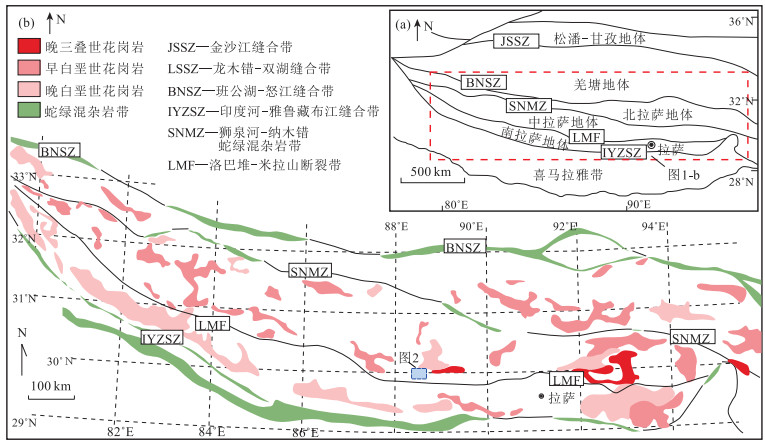
 下载:
下载:
